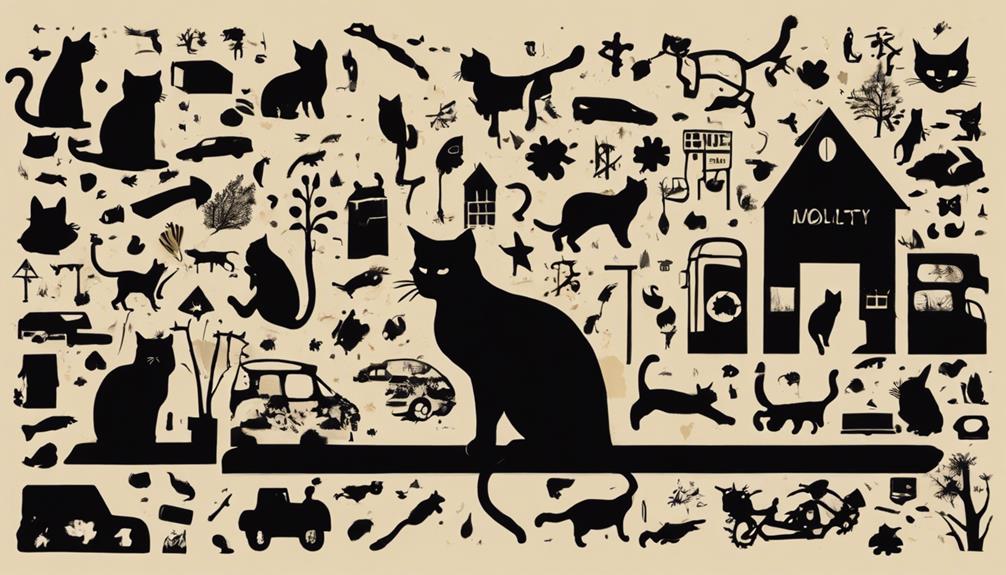Exploring Feral Cats' Lifespan: Facts & Figures
Have you ever wondered just how long feral cats can survive in the wild?
The lifespan of these elusive creatures may surprise you.
From battling the elements to evading predators, feral cats lead a challenging existence that impacts their longevity.
Understanding the factors that influence their lifespan is crucial for ensuring their well-being.
Keep reading to uncover the mysteries behind feral cats' survival against the odds.
Feral Cats' Average Lifespan
When caring for feral cats, understanding their average lifespan is crucial for providing appropriate care and support. Feral cats typically have a lifespan of around 5 years, although some can live up to 10 years or more with the right conditions.
Proper nutrition is essential for feral cats to thrive in their environment. They require a diet rich in protein and nutrients to support their overall health and longevity. This includes a mix of wet and dry food to ensure they receive a well-rounded diet.
Environmental stressors play a significant role in the lifespan of feral cats. Harsh weather conditions, lack of shelter, and exposure to predators can all impact their longevity. Providing safe and secure shelters can help feral cats better withstand these stressors and increase their chances of survival. It's important to create a conducive environment that minimizes potential risks and promotes their well-being.
Factors Affecting Cat Longevity
Factors impacting the longevity of feral cats involve environmental stressors like harsh weather conditions and exposure to predators. Genetic influences also play a significant role as some cats inherit traits that affect resilience to diseases or hunting abilities.
Additionally, environmental factors such as shelter availability and access to food and water can greatly influence a feral cat's lifespan.
Diet quality is a crucial factor affecting longevity, as a balanced diet rich in nutrients is essential for good health.
Social interactions also play a role; cats forming strong bonds within a colony may receive support during hardships, potentially leading to a longer life. Conversely, isolated cats or those in constant conflict may experience stress negatively impacting their health.
Health Challenges in Feral Cats
Feral cats face various health challenges due to their exposure to harsh environments and limited access to veterinary care. These challenges can significantly impact their well-being and longevity. To address these issues effectively, it's crucial to understand the key factors affecting the health of feral cats:
- Disease Prevention: Feral cats are more susceptible to various diseases due to their outdoor lifestyle. They're at risk of contracting illnesses such as feline leukemia virus (FeLV), feline immunodeficiency virus (FIV), and rabies. Preventative measures such as vaccinations and regular health check-ups can help reduce the spread of diseases within feral cat colonies.
- Veterinary Care: Limited access to veterinary care is a significant challenge for feral cats. Without proper medical attention, injuries, infections, and other health issues can go untreated, leading to severe consequences. Initiatives that provide spaying/neutering services, vaccinations, and medical treatment are essential in improving the overall health of feral cat populations.
- Parasite Control: Feral cats are prone to parasites such as fleas, ticks, and worms, which can cause discomfort and health problems. Regular parasite control measures, including flea treatments and deworming, are vital for maintaining the health of feral cats and preventing the spread of parasites within the population.
- Nutritional Challenges: Finding adequate food sources can be a struggle for feral cats, leading to malnutrition and related health issues. Providing access to nutritious food through managed feeding programs can help address nutritional deficiencies and promote better health outcomes for feral cats.
Importance of Spaying/Neutering
To ensure the well-being of feral cat populations, addressing the importance of spaying/neutering is paramount in managing their overall health and population control. Spaying/neutering benefits not only the individual cats but also the community as a whole. By spaying or neutering feral cats, you can prevent the cycle of overpopulation, which often leads to various health issues, fights over territories, and the spread of diseases. Additionally, spaying and neutering can help reduce undesirable mating behaviors such as spraying and yowling, making the cats more compatible with their environment and reducing noise pollution.
Community outreach programs play a crucial role in promoting spaying/neutering practices among feral cat colonies. These programs help educate individuals about the benefits of spaying/neutering, provide resources for affordable procedures, and offer support in managing feral cat populations in a humane way. By participating in community outreach programs focused on spaying/neutering, you actively contribute to the well-being of feral cats and the overall ecosystem. Moreover, these programs create a network of individuals dedicated to caring for feral cats, fostering a sense of community and responsibility towards these animals. Remember, your involvement in spaying/neutering initiatives can make a significant difference in improving the lives of feral cats and ensuring a healthier environment for all.
Impact of Predators on Cat Lifespan
The presence of predators significantly impacts the lifespan of feral cats in their natural habitats. Predator-prey dynamics play a crucial role in shaping the survival rates of feral cat populations.
Here are some key points to consider regarding the impact of predators on cat lifespan:
- Predator Diversity: The variety of predators in a feral cat's environment can greatly influence their lifespan. Cats facing multiple predator species may have a shorter lifespan compared to those in areas with fewer predators.
- Hunting Strategies: Understanding the hunting strategies of predators is essential in predicting the survival rates of feral cats. Cats may adapt their behavior based on the type of predators they encounter, affecting their lifespan.
- Prey Population: Fluctuations in prey populations can indirectly impact feral cat lifespan. A decrease in prey availability due to predation pressure can lead cats to explore riskier territories, exposing them to more dangers.
- Wildlife Management Strategies: Implementing effective wildlife management strategies can help mitigate the impact of predators on feral cat populations. Conservation efforts that aim to balance predator-prey dynamics can contribute to the overall wellbeing and longevity of feral cats.
Understanding the intricate relationship between predators and feral cats is crucial for developing comprehensive wildlife management plans that support the long-term survival of these feline populations.
Tips for Extending Cat Lifespan
Enhancing your feline companion's longevity involves implementing proactive health and wellness measures. One crucial aspect is meeting their nutrition requirements. Providing a balanced diet with high-quality protein, essential vitamins, and minerals is essential for your cat's overall health and longevity. Consult with your veterinarian to determine the best diet plan based on your cat's age, weight, and any specific health conditions they may have.
In addition to nutrition, behavioral enrichment plays a significant role in extending your cat's lifespan. Cats are natural hunters and explorers, so keeping them mentally and physically stimulated is key. Provide interactive toys, scratching posts, and puzzle feeders to prevent boredom and encourage exercise. Rotating toys and creating new play opportunities can prevent behavioral issues and promote a healthy lifestyle for your cat.
Common Causes of Cat Mortality

Keeping your feline friend safe and healthy involves understanding the common causes of cat mortality. Here are some key factors to consider:
- Disease Prevention: Regular vaccinations and preventive care are crucial in safeguarding your cat against common diseases such as feline leukemia, feline immunodeficiency virus, and respiratory infections. By staying up to date with vaccinations and practicing good hygiene, you can significantly reduce the risk of your cat falling ill.
- Environmental Hazards: Cats are curious creatures and may encounter various hazards in their environment. These hazards include toxic plants, chemicals, and human foods that are harmful to cats. Additionally, outdoor cats are at risk of being involved in accidents, such as being hit by vehicles or getting into fights with other animals. Creating a safe indoor environment or supervising outdoor activities can help prevent these risks.
Understanding these common causes of cat mortality and taking proactive steps to mitigate them can help ensure a longer and healthier life for your beloved feline companion. Regular veterinary check-ups, a balanced diet, and a safe living environment are essential components of responsible cat ownership.
Feral Cats' Adaptation to Environment
Understanding the challenges faced by feral cats in their environment sheds light on their remarkable ability to adapt and survive in the wild. Feral cats rely on their innate hunting skills to secure food in the face of food scarcity. These cats have adapted to be efficient predators, using their keen senses and agility to hunt small animals such as rodents, birds, and insects. Their ability to stalk, pounce, and capture prey is crucial for their survival when traditional food sources are limited.
In times of food scarcity, feral cats exhibit remarkable resilience by expanding their hunting grounds and adjusting their diets to include a wider variety of prey. This adaptability allows them to endure lean periods and thrive in diverse environments. Feral cats have also been observed forming colonies to increase their chances of successful hunting and sharing resources within their community.
Their sharp instincts and honed hunting skills enable feral cats to navigate the challenges posed by their environment effectively. By constantly refining their hunting techniques and being opportunistic in their food choices, these cats demonstrate a remarkable capacity to adapt and thrive in the wild.
Frequently Asked Questions
How Do Feral Cats Typically Establish Their Territories?
When feral cats establish their territories, they mark boundaries through scent-marking and vocalizations. This territorial behavior helps them communicate with other cats in the area and prevent conflicts.
What Are Some Common Myths or Misconceptions About Feral Cats' Lifespan?
When it comes to feral cats' lifespan, there are several misconceptions that people believe. Factors like access to food, shelter, and healthcare play a significant role in how long these cats can live.
Some myths suggest that feral cats don't live very long, but with proper care and support, they can actually have a decent lifespan.
It's important to understand the realities and not fall for these common misconceptions surrounding feral cats' longevity.
Can Feral Cats Be Socialized and Integrated Into a Domestic Environment?
Yes, feral cats can be socialized and integrated into a domestic environment. It requires patience and understanding of feral cat behavior. Socialization helps them adapt to human interaction. Challenges may arise due to their wild instincts, but with time and effort, many feral cats can become loving pets.
Domestic integration provides a second chance for these cats to experience a safe and caring home environment.
What Role Do Community TNR (Trap-Neuter-Return) Programs Play in Managing Feral Cat Populations?
TNR programs are crucial in managing feral cat populations. They help control the numbers by trapping, neutering, and returning cats to their habitats. Their effectiveness relies heavily on community support.
When people come together to fund, organize, and implement TNR efforts, it makes a significant impact on curbing feral cat overpopulation. So, supporting TNR initiatives in your area can truly make a difference in managing feral cat populations.
Are There Any Specific Laws or Regulations Regarding the Management of Feral Cat Colonies in Urban Areas?
In urban areas, legal restrictions like city ordinances often regulate the management of feral cat colonies. These laws aim to address public health concerns and animal welfare issues.
Community support plays a crucial role in finding humane solutions for feral cat populations. By working together and adhering to these regulations, cities can create safer environments for both humans and feral cats.
Conclusion
In conclusion, feral cats' lifespan can vary due to various factors such as health challenges, predators, and environmental conditions. By spaying/neutering, providing proper care, and minimizing risks, you can help extend a feral cat's lifespan.
Understanding the challenges they face and taking steps to mitigate them can make a significant difference in the lives of these resilient animals. Remember, every effort counts in ensuring feral cats live longer, healthier lives.
